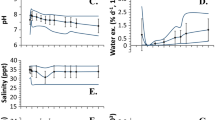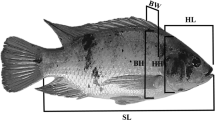Abstract
In ornamental aquaculture, the traits related with beauty are an important factor in the economy and their inclusion in the genetic improvement program is essential. However, in some species, it is difficult to define which traits are important in this sense. The objective of this study was to know the producers’, traders’, and aquarists’ interests of morphometric characteristics associated with the esthetic of Puntius tetrazona for a genetic improvement program. The information was generated from surveys considering aquarists, traders, and producers. The design of the questionnaires consisted of sets of questions according to the type of information that we wanted to obtain: demographic, specific to each actor, and esthetic preferences; the last was a common section for the three actors. The last one is supported by five sets of morphotypes based on the morphometric characteristics with a major contribution to variability in Puntius tetrazona. For the analysis of the preferences of each population for every group of morphotypes, an accumulated ordinal model was utilized. The perception of beauty is not affected by demographic traits. And the morphotypes with a higher preference for inclusion in a selection program to esthetic traits in P. tetrazona would be a short caudal peduncle, medium-length caudal fin, anal fin that is short proximal long and long distal long, wide body marks, and dorsal fin that is 25% gray. For the implementation of genetic improvement programs, it will be important to take into account the differences in interests at two points within the production chain, the needs of the producer and those of the aquarists.


Similar content being viewed by others
References
Adorno TW (1971) Teoría estética. Taurus ediciones, España
Agresti A (2010) Analysis of ordinal categorical data. 2nd edition. John Wiley and Sons, Inc. Publication, United States of America
Auró A, Gallo GC (2006) Acuariología básica de agua dulce. (CD-ROM). FMVZ-UNAM, México
Beaumont AR, Hoare K (2003) Biotechnology and genetics in fisheries and aquaculture. Blackwell, Great Britain
Blanco DF (2004) El arte en la medicina: Las proporciones divinas. Ciencia UANL VII (2) abril-junio: 150-156
Breintenstein A (2004) Atlas ilustrado del acuario. Susaeta, España
Campos-Montes GR, Montaldo HH, Martínez-Ortega A et al (2013) Genetic parameters for growth and survival traits in Pacific white shrimp Penaeus (Litopenaeus) vannamei from nucleus population undergoing a two-stage selection program. Aquacult Int 21:299–310. https://doi.org/10.1007/s10499-012-9553-1
Casey NG (2016) The ornamental freshwater fish trade in Malaysia the collection, breeding and marketing of ornamental fishes is a sizable industry. UTAR Aquaculture Science Journal 2(4):7–18
Castillo-Juárez H, Quintana CJC, Campos-Montes G et al (2007) Heredability for body weight at harvest size in the Pacific white shrimp, Penaeus (Litopenaeus) vannamei, from a multi-environment experiment using univariate and multivariate animal models. Aquaculture 273:42–49. https://doi.org/10.1016/j.aquaculture.2007.09.023
Dasgupta S, Durborow R (2009) Small-scale marketing of aquaculture products. SRAC Publication 350
Gulimar I, Rizal A, Sriati R, Setiwan P (2018) Analysis of consumer behavior in decision making of purchasing ornamental freshwater fish (case of study at ornamental freshwater fish market at Peta Street, Banddung). IOP Conf. Ser: earth environ. Sci. 137 012081. DOI https://doi.org/10.1088/1755-1315/137/1/012081
Kumari A, Kumar S, Kumar A (2017) Study of life compatibility and growth of selected ornamental fishes under aquarium in Sanjay Gandhi Biological Park. Int J Curr Microbiol app Sci 6(12):3166–3172. https://doi.org/10.20546/ijcmas.2017.612.370
Levine DM, Krehbiel TC, Berenson ML (2006) Estadística para administración, 4ta edn. Pearson Educación, México
Maceda-Velga A, Domínguez-Domínguez O, Escribano-Alacid J et al (2014) The aquarium hobby: can sinners become saints in freshwater fish conservation? Fish fish 17:860–874. https://doi.org/10.1111/faf.12097
Malhotra NK (2016) Investigación de mercados, conceptos esenciales. Pearson Educación, México
Martínez PP, Figueras HA (2007) Genética y genómica en acuicultura. Publicaciones científicas y tecnológicas del Observatorio Español en Acuicultura, Spain
Martínez ED, Malpica SA, Hernández AJ (2010) Estructura de la producción de la piscicultura de ornato del estado de Morelos y su relación con la diversidad de la oferta. Sociedades Rurales, Producción y Medio Ambiente 10(20):15–36
Monticini P (2010) The ornamental fish trade. Production and commerce of ornamental fish: technical-managerial and legislative aspects. GLOBEFISH Research Programme, Vol. 102. FAO, Rome, p 134
Naini FB, Moss JP, Gill DS (2006) The enigma of facial beauty: esthetics, proportions, deformity, and controversy. Am J Orthod Dentofac Orthop 130(3):277–282. https://doi.org/10.1016/j.ajodo.2005.09.027
Nightingale D, Krishnan M, Ananthan PS, Pawar N (2017) A producer company- An ideal value chain model for ornamental fish trade. IJFAS 5(6):115–120
Panchen AL (1992) Classification, evolution, and the nature of biology. Cambridge University Press, USA
Rivero MPV, Campos MGR, Lugo GAT et al (2016) Discriminación de caracteres morfométricos de interés ornamental candidatos a criterios de selección en Barbo Sumatrano (Puntius tetrazona). Sociedades Rurales, Producción y Medio Ambiente 32(17):123–142
Tamaru CS, Cole B, Bailey R, et al (1997) Manual for commercial production of the Tiger Barb, Capoeta tetrazona, a temporary paired tank spawner. Center for Tropical and Subtropical Aquaculture (129), USA
Tolon MT (2017) Determination of hobbyist preferences for livebearer ornamental fish attributes by conjoint analysis. Turk J Fish Aquat Sci 18:119–126. https://doi.org/10.4194/1303-2712-v18_1_13
Acknowledgements
The authors are thankful to CONACyT, Mexico, for funding the first author’s PhD scholarship (reg. no. 492258) and for providing funds for this research through the project “Estrategias para la capitalización de pequeñas unidades acuícolas en el estado de Morelos” of the Universidad Autónoma Metropolitana-Xochimilco.
Author information
Authors and Affiliations
Corresponding author
Ethics declarations
Conflict of interest
The authors declare that they have no conflicts of interest.
Ethical approval
This article does not contain any studies with animals performed by any of the authors.
Additional information
Publisher’s note
Springer Nature remains neutral with regard to jurisdictional claims in published maps and institutional affiliations.
Rights and permissions
About this article
Cite this article
Rivero-Martínez, P.V., Castillo-Juárez, H., Cienfuegos Rivas, E.G. et al. Analysis of the preferences of the esthetic traits and their morphotypes candidates to selection criteria in Tiger barb (Puntius tetrazona) in the actors of the productive chain. Aquacult Int 28, 1043–1055 (2020). https://doi.org/10.1007/s10499-020-00510-7
Received:
Accepted:
Published:
Issue Date:
DOI: https://doi.org/10.1007/s10499-020-00510-7




